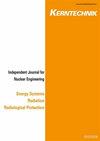巴基斯坦球形托卡马克导流器设计优化
IF 0.4
4区 工程技术
Q4 NUCLEAR SCIENCE & TECHNOLOGY
引用次数: 0
摘要
处理功率沉积、减小冲蚀效应和等离子体结构是分流器设计的关键因素。巴基斯坦球形托卡马克(PST)的设计基于双零导流器配置,主动冷却石墨靶在外/内击点,峰值热流范围容量为0.1-0.3 MW/m2。PST分流器模块的配置采用了模型(在挡板和圆顶上使用平面型瓦片)和卡式(支持PFC和冷却通道)技术设计。导流器分为氦冷级和水冷级两种。因此,本文的一部分研究重点是转向器水冷却系统。本文介绍了带冷却通道的PST导流器的设计和导流器的材料分析,分三个阶段进行。在第一阶段,估计等离子体边缘温度、密度、粒子速度、输入功率、热流密度和表面温度。第二阶段进行了导流系统的物理和工程设计。在第三阶段,通过COMSOL模拟分析了材料性能、稳定热流流下的表面温升(∆T °C)以及导流器的热液压系统。分析发现,比热通量在0.3 MW/m2 ~ 3 s为安全区极限。研发工作证实,制造和安装工艺对于所建议的导流器设计是合理的。本设计能够满足PST的要求。然而,增加时间或比热通量超过这些限制将需要重新设计冷却通道。本文章由计算机程序翻译,如有差异,请以英文原文为准。
Optimization of divertor design for Pakistan spherical tokamak
Abstract Handling the power deposition, reducing erosion effects, and plasma configuration are the key factors in the design of a divertor. The design of Pakistan Spherical Tokamak (PST) is based on double-null divertor configuration with actively cooled graphite targets at outer/inner strike point and peak heat flux range capacity of 0.1–0.3 MW/m2. The configuration of PST divertor module is designed with mock-up (used flat type tiles on baffles and dome) and cassette (support PFC and cooling channels) technology. Helium-cooled stage and water-cooled stage are two options for divertor. Therefore, one part of this research is focused on water-cooling system for the divertor. This paper presents the divertor design for PST with cooling channel and material analysis of the divertor, which is carried out in three phases. In the first phase, the plasma edge temperature, density, particle velocity, input power, heat flux, and surface temperature are estimated. In second phase, physics and engineering design of divertor system has been performed. In the third phase, COMSOL simulation has been performed to analyses the material properties, surface temperature rise (∆T °C) at stable heat flux, and thermal hydraulic system for the divertor. It is found from the analysis that the specific heat flux of 0.3 MW/m2 up to 3 s is the safe zone limit. The R & D work ratifies that manufacturing and installation processes are plausible for the proposed divertor design. This design is able to meet the requirement of PST. However, increasing time or specific heat flux beyond these limits would require redesigning of the cooling channel.
求助全文
通过发布文献求助,成功后即可免费获取论文全文。
去求助
来源期刊

Kerntechnik
工程技术-核科学技术
CiteScore
0.90
自引率
20.00%
发文量
72
审稿时长
6-12 weeks
期刊介绍:
Kerntechnik is an independent journal for nuclear engineering (including design, operation, safety and economics of nuclear power stations, research reactors and simulators), energy systems, radiation (ionizing radiation in industry, medicine and research) and radiological protection (biological effects of ionizing radiation, the system of protection for occupational, medical and public exposures, the assessment of doses, operational protection and safety programs, management of radioactive wastes, decommissioning and regulatory requirements).
 求助内容:
求助内容: 应助结果提醒方式:
应助结果提醒方式:


